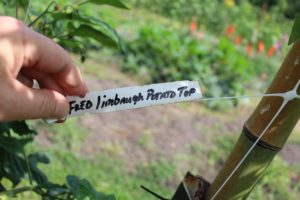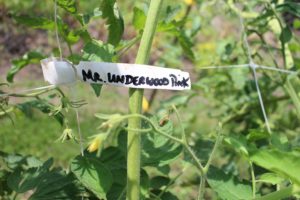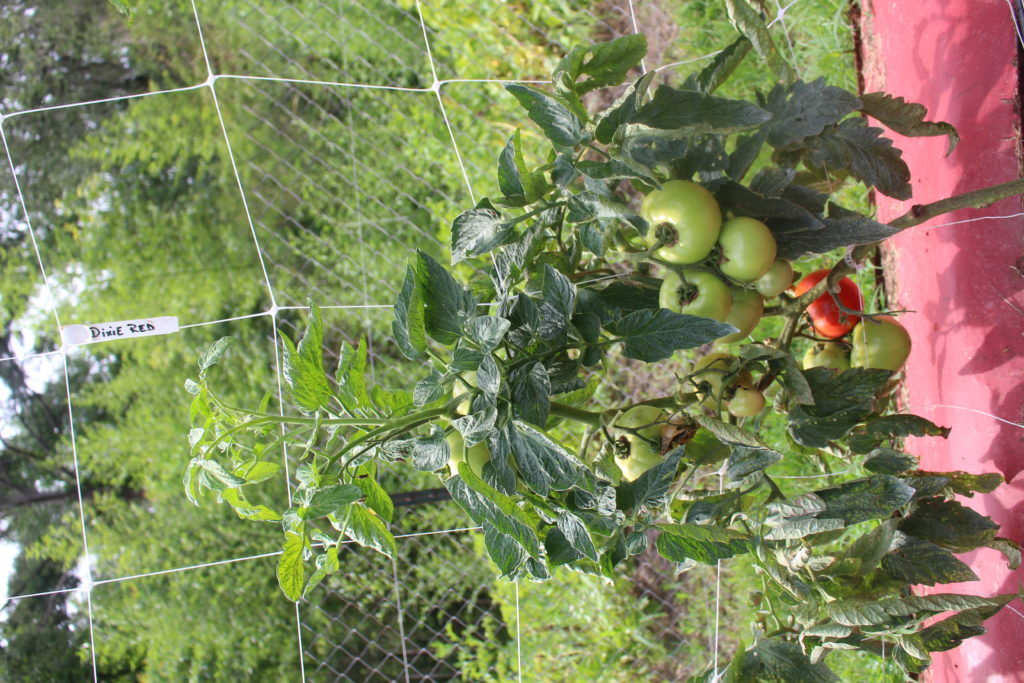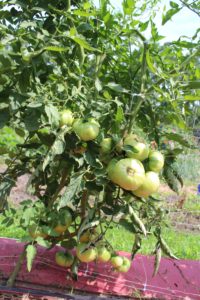I was about to give up growing tomatoes. It’s very challenging in the South-so many diseases to control. But, I don’t like to give up so I went all out this year and had the best crop ever. In fact, most of our the freezer is filled with tomato sauce, courtesy of my wife. Not sure what the moral of the story is because I spent quite a few bucks to get to this outcome.
 I grow about 80 varieties purchased from Johnny’s Selected Seeds, Totally Tomatoes and Tomato Fest and others. Depending on past success, I start from seed between three and 18 of each variety which means 400-500 plants, crazy, compulsive…I agree, but in years past I grew 700 plants. I only transplant about a hundred plants. I have a lot of friends during planting time but no friends during weeding time. I’ve had success with Creole, Ceylon, Big Rainbow, Camp Joy and Giant Belgium. All have fantastic taste! Surprisingly this year Japanese Black Trifelle, Kentucky Beef, Morado Vejer del la Frontera, Spudatula Black, Tim’s Black Ruffles and Uncle Remi out performed. All delicious.
I grow about 80 varieties purchased from Johnny’s Selected Seeds, Totally Tomatoes and Tomato Fest and others. Depending on past success, I start from seed between three and 18 of each variety which means 400-500 plants, crazy, compulsive…I agree, but in years past I grew 700 plants. I only transplant about a hundred plants. I have a lot of friends during planting time but no friends during weeding time. I’ve had success with Creole, Ceylon, Big Rainbow, Camp Joy and Giant Belgium. All have fantastic taste! Surprisingly this year Japanese Black Trifelle, Kentucky Beef, Morado Vejer del la Frontera, Spudatula Black, Tim’s Black Ruffles and Uncle Remi out performed. All delicious.


In February I start my plants in the greenhouse, using purchased seed starter mix. I barely cover the seeds with vermiculite. This keeps the seeds moist and I also cover the tray with a clear plastic cover to help keep the temperature even and also to prevent the soil from drying. The trays are placed on a heat mat to keep an even temperature. The seeds sprout in under a week.

After the plants sprout, the covers are removed and the sprouted plants are removed from the heat mat. Once they grow to about three inches tall, I transplant them into 10” pots and use garden soil. Mixed in with the soil is aged horse manure, azomite [1] for minerals, crab shells [2]and slow release fertilizer (ditto). My garden soil is very sandy and lacks nitrogen, organic matter and calcium. Organic matter makes for healthier soil; slow release fertilizer avoids the sudden burst of growth that pure fertilizer will cause; and of course, crab shells provide calcium and helps stimulate beneficial soil bacteria; and lastly, Epson salt for magnesium. All these ingredients are very important for healthy tomatoes.

Transplanting:
I use a BCS rototiller because it has the horsepower and attachments I need to mix in manure and build raised beds. Next I roll out the drip hose to regulate the water the plants receive (no overhead watering please skull & bones). Then we roll out the red carpet, red plastic mulch to suppress weeds, keep harmful soil microbes from reaching the plant leaves plus research shows tomatoes produce a better crop when grown over red plastic. It’s important to keep the plants off the ground so I attach them to 5’ high plastic netting. Using a blow torch, I cut a round hole in the plastic every 30 inches. I like plenty of air around my plants.
This may seem like a lot of work but it saves weeding time, reduces plant stress, controls water and provides a great growing environment.
Disease management:
Finally, the plants go into the ground with more crab shells, slow release fertilizer and azomite and Epsom salts. As the plants grow I stake them with tomato clips or use the max tapener to attach the vine to the trellis. As the plants grow, I remove most suckers and also I remove the bottom leaves. As we work down the line trimming and pruning, I wear latex glove and frequently wash my hands in a Clorox-water solution hoping not to transmit disease between plants.

I used to garden on Long Island and it had plenty of disease challenges, but the hot humid South is an incubator for every tomato disease imaginable and I use biologics on the plant and water it into the soil too. I believe it’s the difference between no tomatoes and success! So what do is I use, Neem on the plants to control aphids and flies, Double Nickel for fungus, Serenade for soil born diseases and Cease and Dipel for caterpillar control.
Despite all this effort, I still had leaf curl and quite a few watery tomatoes. We had so much rain that the soil, despite the plastic mulch was constantly saturated. Oh and the birds pecked at their fair share. Lastly we had to electric fence the entire tomato patch, my tomatoes were just to tasty and the raccoons climbed my 8’ fence to get to them. As soon as a tomato ripened they ate it so out of desperation we built an 4’ electric fence.
The photos are proof, we had the biggest crop ever, never have I had such productive plants! They were worth the effort.
Extra information:
Epson salts: Here a great blog by bobvila on Epson salts for your garden. https://www.bobvila.com/articles/epsom-salts-in-the-garden/
Azomite For Plants & Animals Granular – This naturally mined, volcanic mineral has over 66 minerals and trace elements that are important for plant nutrition and growth. It improves depleted soils. Apply with compost, humus, manures or other fertilizers to provide additional levels of nitrogen, phosphorus, and potassium. Will not burn plants.
[1] Azomite: is a naturally mined, volcanic mineral has over 66 minerals and trace elements that are important for plant nutrition and growth.
[2] Crab Shell: Made from 100% Blue Crab with no other additives. Crab shell is an excellent source of NPK, Calcium, (18%) and micro nutrients. The high levels of chitin in crab shell creates a perfect feeding ground for chitin eating bacteria; thereby increasing the bacteria’s population. These bacteria in turn feed on the chitin containing cell walls of nematodes and fungi present in the soil. The increased presence of chitin in the soil also triggers a defense response in the plant causing a release of chitin destroying enzymes, thus increasing the plants’ defense mechanisms and immune response. In this way, the crab shell inadvertently creates a hostile environment for nematodes and fungi and strengthens plants.










